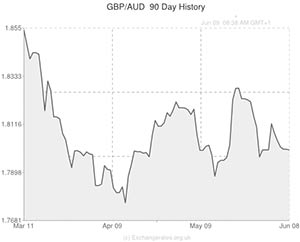
The Pound to Australian Dollar exchange rate (GBP/AUD) softened by around a quarter of a cent last night as investors in the Asia-Pacific region responded to news that the Japanese economy expanded at an annual pace of 6.7% in the first quarter of the year. Sterling also rallied by around a third of a cent versus the New Zealand Dollar (GBP/NZD) in reaction to the data.
Beating expectations of growth of 5.5%, it was reported that the world’s third largest economy actually expanded by 6.7% in the first three months of the year. A massive 34.2% surge in capital investment contributed strongly to the upward revision, helping Japan register its sixth consecutive quarter of robust growth. A sales splurge ahead of the sales tax increase – from 5% to 8% – on April 1st also drove GDP higher as consumers sought to make the most of the lower tax rate.
On a quarterly basis the Japanese economy expanded by 1.6%, higher than the estimated 1.4%.
The sturdy GDP report boosted risk sentiment in the region as investors predicted that strong domestic growth in Japan would lead to enhanced trading patterns in Australia and New Zealand. GBP to AUD fell from 1.8000 to 1.7975 and GBP to NZD slid from 1.9770 to 1.9740.
Japanese Prime Minister Shinzo Abe has breathed life into the stagnant Japanese economy with his expansive ‘Abenomics’ stimulus programme. However, there are fears among investors that Gross Domestic Product will actually shrink by around -4.0% during the second quarter as consumers and manufacturers adjust to the new 8% sales tax hike.
There are no high profile UK data releases today meaning that demand for GBP/AUD and GBP/NZD is likely to be dictated by investors’ appetite for risk. Although the Bank of England looks set to start hiking interest rates at some point in the next 12 months it looks as though the Pound could struggle to appreciate versus the Antipodean currencies during today’s session.
Risk sentiment remains high following the European Central Bank’s decision to loosen monetary policy last Thursday. The ECB cut the benchmark interest rate by 10 pips to 0.15%, reduced the deposit rate by 10 pips to -0.10%, stopped sterilising Eurozone sovereign bonds purchased under the SMP programme and announced a €400 billion liquidity boosting scheme. The monetary easing measures took Sterling to an 18-month high against the Euro.
Demand for perceived riskier assets was also boosted on Friday by news that the US economy added 217,000 jobs during May. The world’s largest economy has now created over 200,000 jobs for four months in a row for the first time since 1999. The robust NFP report also marked a symbolic victory for the United States as it showed that the US economy has now recovered all the jobs that were lost as a result of the financial crisis. GBP/USD declined slightly in reaction to the labour market data.
The Pound could gain some ground versus the ‘Aussie’ on Wednesday when UK unemployment is forecast to fall from 6.8% to 6.7%, but demand for the ‘Kiwi’ could be underpinned by expectations that the Reserve Bank of New Zealand is going to raise interest rates from 3.00% to 3.25% on Wednesday evening. If the RBNZ strikes a hawkish tone with regards to hiking interest rates further in the future then it will likely bolster demand for the New Zealand Dollar.

Comments are closed.